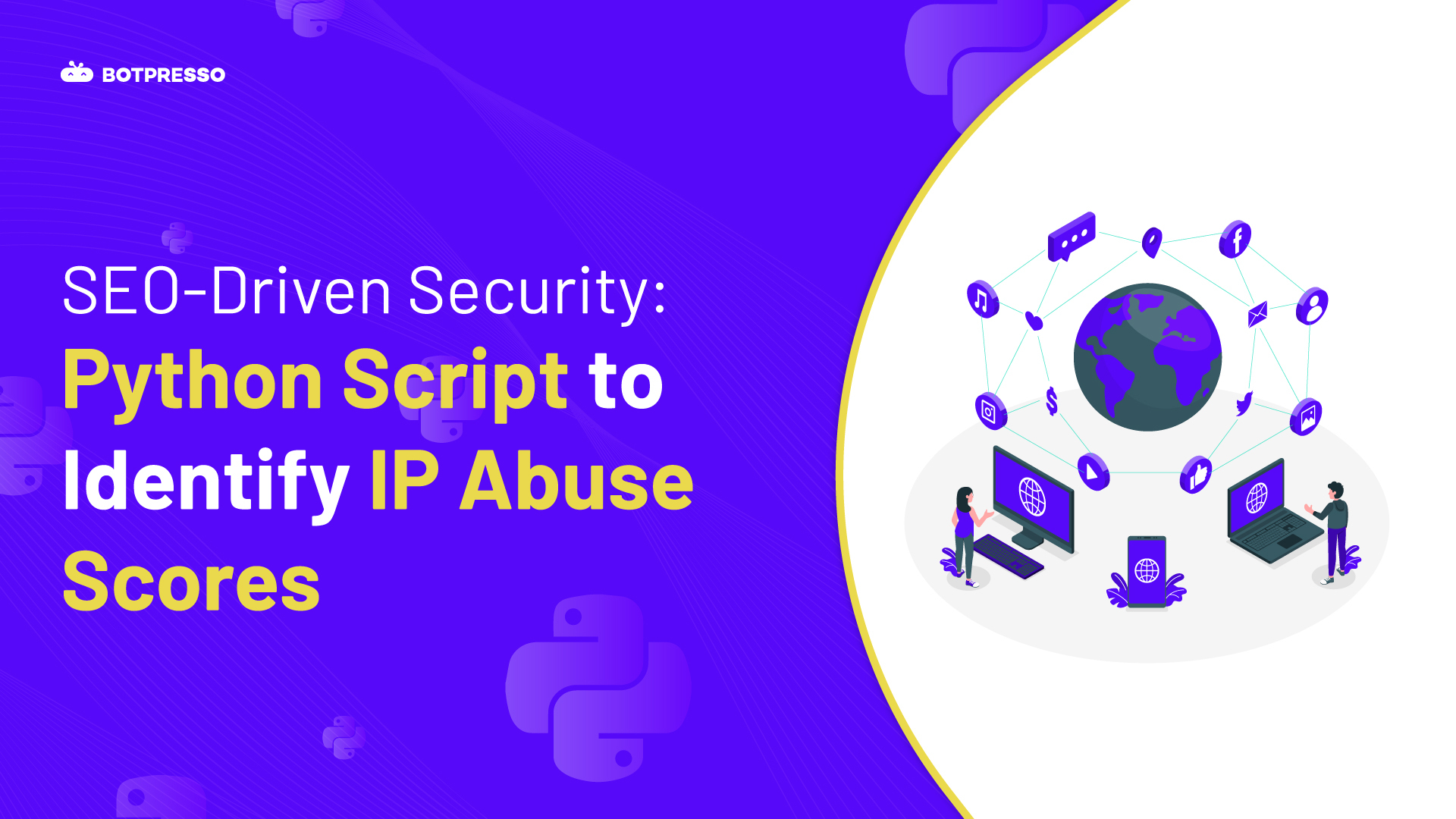What is SaaS SEO?
Ever tried searching for your favorite SaaS tool online and wondered why it’s buried deep on the 10th page of search results? That’s where a solid SaaS SEO strategy and content strategy for SaaS come into the picture! SaaS, short for “Software as a Service,” when paired with SEO, or “Search Engine Optimization,” becomes a powerful combination. It’s all about optimizing a website to boost its visibility on search engines, specifically for products and services offered by SaaS companies. This isn’t just about a one-time SaaS content audit or sprinkling some keywords. It’s a comprehensive approach that includes thorough keyword research, site-wide technical audits, enhancing on-page SEO elements, aligning user intent with product offerings, crafting top-notch SEO content for SaaS, and securing backlinks from authoritative sources.
The Software as a Service model is experiencing rapid growth in today’s digital landscape. It presents an opportune moment for SaaS brands to expand. However, the challenge lies in outshining competitors and establishing oneself as a leading SaaS brand in a specific niche. Through SaaS SEO, companies can leverage online marketing techniques to amplify their website’s visibility, attracting more users and converting them into loyal customers.
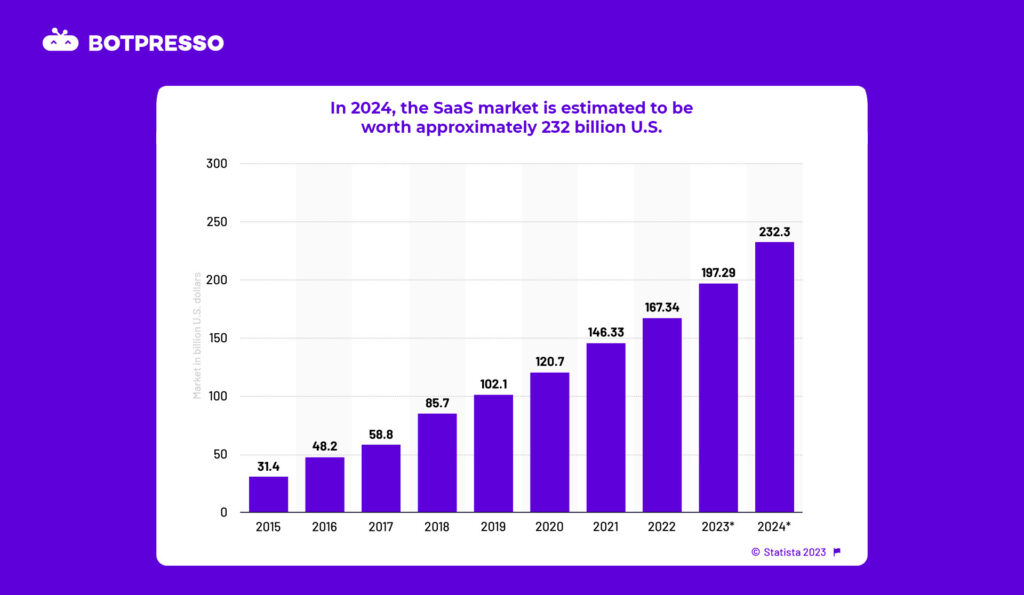
Source: Statista
Key Pillars of an Effective Content Strategy for SaaS
Understand Your Target Audience
At the heart of a successful SaaS content strategy is a deep understanding of your target audience’s persona and demographics. Your target audience comprises specific consumers most likely to need your product or service. They are the ones who should primarily see your web pages on the SERP. Factors like age, gender, income, location, and interests often define this audience. You can gain insights by conducting market research, identifying industry trends, analyzing competitors, creating personas, and conducting polls and interviews. For SEO consultants, if you find it challenging to perform a thorough analysis, always consider seeking input from your clients. They often hold the missing piece to the SaaS SEO strategy puzzle.
Conduct Keyword Research Based on Search Intent
Search engines aim to provide users with relevant results. Hence, understanding search intent is vital for ranking. A deep grasp of search intent allows you to craft an effective content strategy by targeting keywords that resonate with your audience’s needs.
Map the Keywords to the Buyer’s Journey in Your SaaS Content Strategy
The buying cycle’s intricacies are essential for effective keyword mapping. A customer’s journey can be extensive, from recognizing a problem to deciding on a solution. By its end, they’ve assessed various options and are set to purchase. To transform these potential leads into loyal customers, it’s crucial to synchronize your keyword research and content strategy for SaaS with every phase of the buyer’s journey.
The buyer’s journey represents a customer’s stages, from initial research to the final purchase decision. Here’s a breakdown
- Awareness (Problem)
At this stage, potential customers realize they have a problem but might not know the solution. Keywords here might revolve around questions or pain points related to their issue. Sample keywords include what is SEO, importance of SEO, etc.
- Comparison (Identifying)
Now, they know potential solutions and compare different products or services. Keywords might include specific product names, features, or comparisons. Sample keywords include best SEO tools, Ahrefs vs Sermush, etc.
- Consideration (Evaluation)
Customers have narrowed down their options and are diving deeper into the specifics of each solution. Keywords could be more detailed, focusing on benefits, reviews, or use cases. Sample keywords include Moz features and benefits, Ahrefs reviews, etc.
- Buying (Solution)
They’ve made up their mind and are looking for the best place or way to make a purchase. Keywords here are transactional, like “buy [product name]” or “[product name] discount.” Sample keywords include buy Quickblink tool, Sermush discount codes, etc.
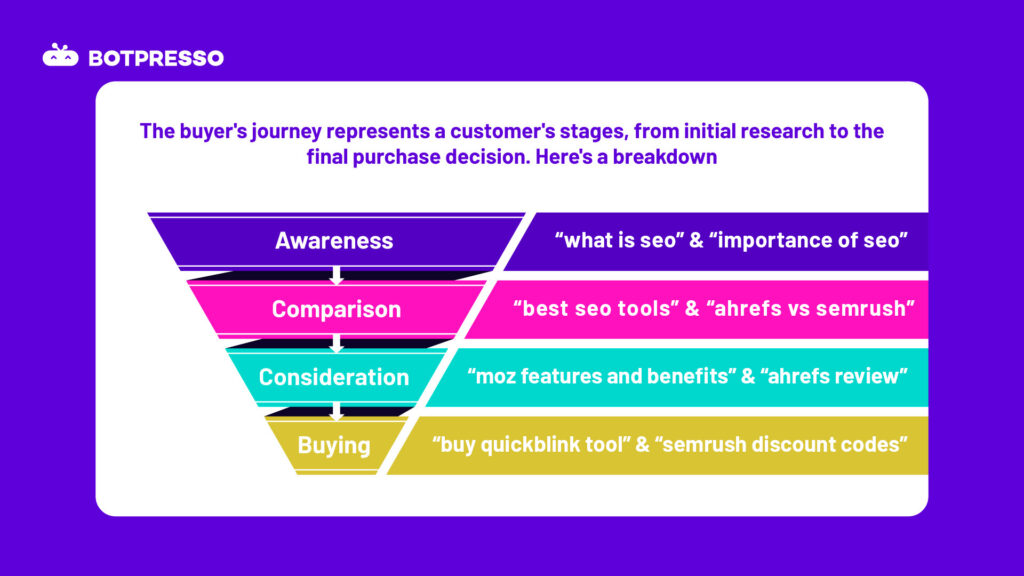
By effectively mapping keywords to each stage of the buyer’s journey, you ensure that you’re addressing the specific needs and questions of your potential customers. After providing all the necessary information and addressing their concerns, you increase the likelihood of guiding the visitor toward making a purchase decision.
For those looking to ensure they’ve covered all bases, our comprehensive SaaS SEO Checklist provides a step-by-step guide to optimizing your SaaS website effectively
Create valuable content
After gaining insights into your target audience, understanding their journey, and identifying the right keywords, the next step in your SaaS SEO content strategy is crafting compelling content. For SaaS companies, content serves multiple purposes, it is not only for capturing attention but also to inform, engage, and ultimately convert those visitors into customers.
By “valuable content,” we truly mean content that enriches the user’s experience. This is where your in-depth knowledge of the target audience, gained from your SaaS content audit becomes instrumental. However, producing high-quality SEO content for SaaS requires a significant investment of time and resources, and at the end of the day, leaders are looking for an investment that yields a tangible return.
Remember, it’s not just about catering to what people want. To truly add value, your content strategy for SaaS should address what your audience genuinely needs.
Crafting a SaaS Content Marketing Strategy
After creating content, the next step is to promote it. Start by sharing it across social media channels, including Facebook, LinkedIn, YouTube, Twitter, Instagram and others. A mere post with a link to your SEO content for SaaS can spark engagement.
Additionally, consider sending an email broadcast to your list—comprised of individuals who’ve shown interest in your product or service and wish to stay updated. In today’s content-saturated digital landscape, even exceptional content can go unnoticed.
PR outreach offers a solution. By reaching out to relevant journalists, editors, bloggers, and influencers, you can ensure your content gets the attention it deserves. Whether your content is data-driven, emotionally resonant, or offers a unique perspective, the right promotion can lead to increased social shares, media coverage, and a broader audience reach.
Effective Strategies for SaaS SEO Content Mastery
Use of Money Keywords for Building SaaS Content for SEO
| Topics | Examples |
|---|---|
| {number} Top/Best {product/service} to try in {year} | 10 Best SEO Tools to Try in 2023 |
| {product/service}: The Ultimate Guide/The Definite Guide/The Last Guide | Rank Tracking by SERanking: The Ultimate Guide |
| 10 Best {product/service} for {industry} | 10 Best SEO Software for eCommerce |
| Best {product/service} for {use_size} | Best SEO Tools for Small Businesses |
| {product} for {use_case} | Content Audit Tools for Content Analysis |
| {product} checklist eBook / PDF download | SaaS SEO Checklist: Free PDF Download |
Use of Competitors’ Brand Names for Building SaaS Content for SEO
| Topics | Examples |
|---|---|
| {competitor_brand} Alternatives for {year} | Semrush Alternatives for 2023 |
| {competitor_brand} Vs. {2nd_competitor_brand} Vs. {3rd_competitor_brand} | Semrush Vs. Ahrefs Vs. Moz: Which Tool is Best for you? |
| {competitor_brand} Vs. {2nd_competitor_brand} Vs. {your_brand} | Semrush Vs. Ahrefs Vs. QuickBlink |
| {competitor_brand} Vs. {your_brand} | Ahrefs Vs. QuickBlink: Here’s what the Industry Says! |
| {competitor_brand} Review | Moz Pro Review: The Good and Bad |
| Is {competitor_brand_name} worth it? | Is Moz Pro worth it? Detailed Analysis |
| Advantages and Disadvantages/Pros and Cons of {competitor_brand_name} | Advantages and Disadvantages/Pros and Cons of {competitor_brand_name} |
Using Your Brand Name for Building SaaS Content for SEO
| Topics | Examples |
|---|---|
| {your_brand_name} Alternatives in {year} | Quickblink Alternatives to Try in 2023 |
| {your_brand_name} Vs Other {keyword} | Quickblink Vs Other SEO Tools |
| Case Study: How {your_brand_name} helped {customer_brand_name} grow their revenue by {percentage} in {number} months | Case Study: How Quickblink helped Headout increase revenue by 256% in 6 months |
| Is {your_brand_name} a good {keyword} | Is Quickblink a good SEO tool? |
| Is {your_brand_name} worth it? | Is Quickblink worth it? |
| Is {your_brand_name} for free? | Is Quickblink available for free? |
Advanced Strategies to Elevate Your Content Strategy for SaaS
Leveraging Infographics in Content Marketing
Infographics are a powerful tool for enhancing a brand’s content marketing strategy. They offer a visually appealing way to convey complex information, making it easily digestible for the audience. Beyond being just visually appealing, infographics can:
- Boost engagement on social media platforms due to their shareable nature.
- Enhance visibility in Google’s image search results.
- Serve as effective link-building tools, with high-quality infographics often attracting backlinks and shares, which can improve search engine rankings for relevant keywords.
Offering Free Tools and Resources
Creating free tools and resources page on your website can significantly enhance user experience and foster trust in your brand. These resources not only drive traffic but also act as potential link magnets, a strategic move in your SaaS SEO strategy. By offering valuable tools and resources, you not only attract more visitors but also encourage repeat visits, solidifying your brand’s position as a trusted industry authority.
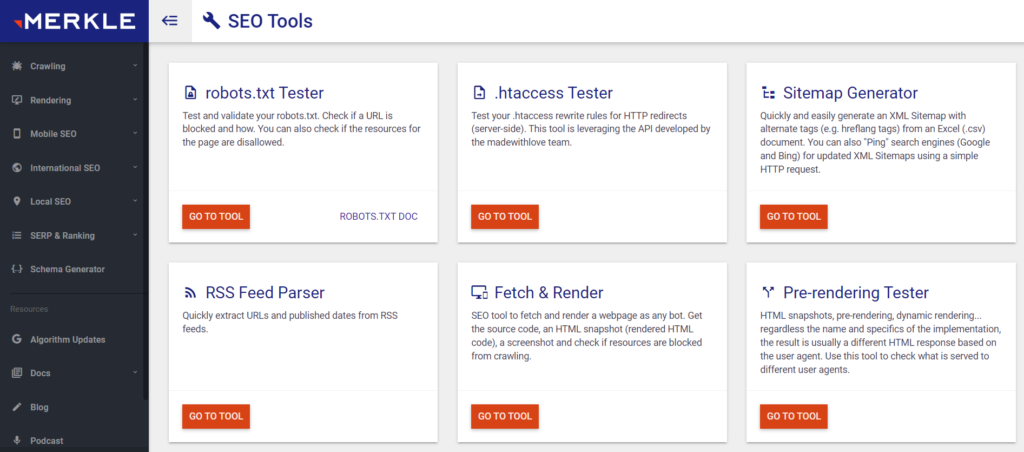
Here is a glimpse of free SEO tools by Merkle, a leading data-driven customer experience management (CXM) company.
Optimizing for Featured Snippets
Securing a featured snippet on search engines places you in the coveted “position zero,” the highest organic ranking spot available (if we don’t consider SGE for now). Featured snippets can significantly boost conversions, drive traffic, and give you a competitive edge. They offer a direct answer to user queries, making it easier for users to find relevant information without navigating away from the search results page.
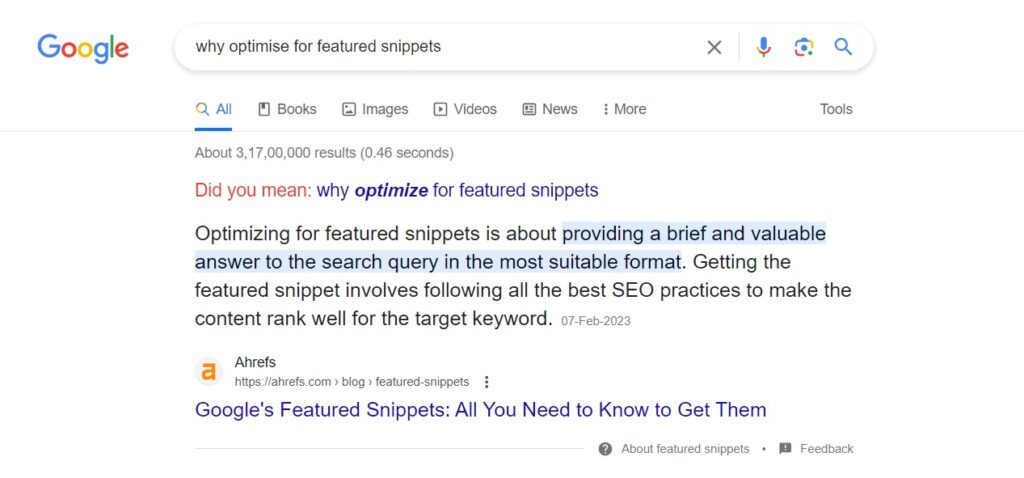
Here’s a glimpse of how Ahrefs, a SaaS company manages to rank for featured snippet grabbing almost 50% of the SERP real estate on the first fold
Tapping into Low-Hanging SEO Opportunities
After implementing primary content strategies, it’s time to explore low-hanging fruit keywords. Utilize tools like Google Search Console to identify these potential keywords. Additionally, user-generated content platforms like Quora and Reddit can be goldmines for uncovering real queries from users. By optimizing your content around these insights, you not only discover new avenues but also ensure your content is tailored for real user needs, aligning with Google’s emphasis on user-centric content.
Elevate your SaaS Content Game with this Strategic Playbook
In the evolving world of SaaS, mastering SaaS SEO content strategy is paramount. By understanding your audience, aligning your content strategy with their needs, and effectively promoting your content, you can ensure your brand stands out in a crowded marketplace. Continuous learning and adaptation are key to staying ahead of the curve and ensuring your SaaS product remains visible and relevant to your target audience. For a deeper dive into the real-world impact of these strategies, explore our detailed SaaS SEO Case Study, showcasing how the right approach can lead to significant growth.
Want more golden nuggets of SEO wisdom? Don’t miss out! Follow me on Linkedin and Twitter for exclusive insights, tips, and real-time updates!


